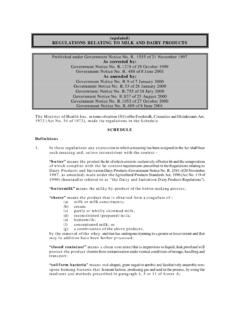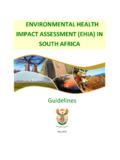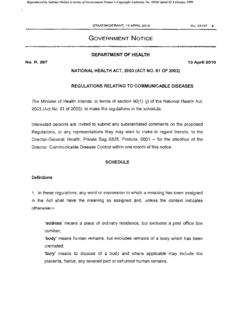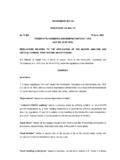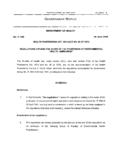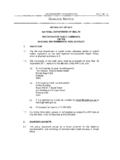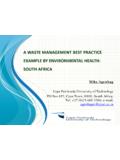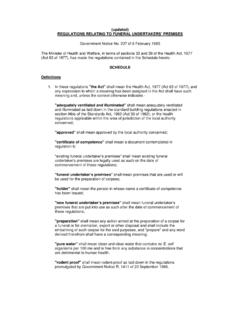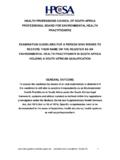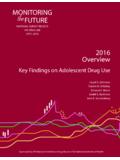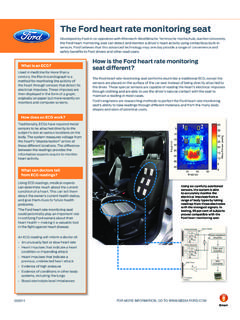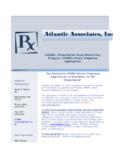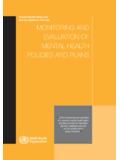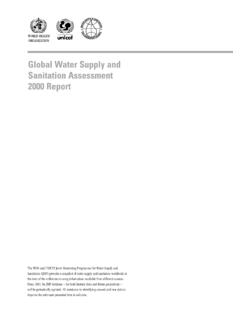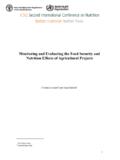Transcription of AIR QUALITY MONITORING AND EVALUATION …
1 AIR QUALITY MONITORING AND EVALUATION TOOLS FOR. HUMAN HEALTH RISK REDUCTION IN SOUTH AFRICA. Caradee Wright1 and Rietha Oosthuizen CSIR Environmental Health Research Group, Pretoria, South Africa. 1. Abstract Air pollution is a serious environmental health threat to humans. Adverse effects range from nausea, difficulty in breathing and skin irritations, to birth defects, immuno-suppression and cancer. Moreover, the severity of health outcomes associated with air pollution exposure is not uniform within populations. In South Africa, the problem is exacerbated since vulnerable communities reside on land in close proximity to pollution sources. New air QUALITY legislation aims to protect the health of South Africans through the implementation of air QUALITY management plans and air QUALITY MONITORING programmes. To assess the effectiveness of these actions and implemented mitigation measures with respect to health outcomes, specific indicators are required. Air QUALITY MONITORING and EVALUATION tools were reviewed to consider their application in South Africa.
2 For effective protection of human health, information on air pollution source, type and concentration is essential, but so are data on the severity and magnitude of adverse health effects both spatially and temporally. Information on population exposure and exposure-health associations derived from epidemiological evidence is also required. While it is acknowledged that ambient air QUALITY limits were established from the documented effects of air pollution exposure on human health, air QUALITY MONITORING and EVALUATION methods for South Africa should also consider the EVALUATION of air QUALITY results in relation to specific health outcomes. Keywords: air pollution, health, population exposure 1. Introduction from nausea, difficulty in breathing and skin irritations, to birth defects, immuno-suppression and Air pollution comprises both indoor and outdoor cancer (Kampa and Castanas, 2008). An increase pollution. Outdoor air pollution is largely a in hospital admissions has been associated with consequence of fossil fuel combustion for transport increased air pollution (Brunekreef and Holgate, and electricity generation, industrial non-fossil fuel 2002), however, the difficulty lies in determining emissions and other human activities.
3 Indoor air which air pollutant is responsible. The air inhaled by pollution usually results from the burning of wood, an individual is a mixture of gases, including air coal or paraffin for space heating, cooking and pollutants such as particulate matter, which may lighting purposes. differ in composition. Also, exposure may vary by Air pollutants may be grouped into four concentrations, duration and timing, further categories: complicating analysis of actual causation. 1. Gaseous pollutants, sulphur dioxide, Several epidemiological studies have carbon monoxide, ozone. considered the associations between air pollutants 2. Persistent organic pollutants, and adverse health effects (Dockerty, 1993; Pope et dioxins. al., 2002). However, confounding factors, such as 3. Heavy metals, lead, mercury. smoking, and challenges relating to pollution 4. Particulate matter, PM10. composition and mixture, as well as personal Inhalation of air pollutants is a major exposure, prevent concrete evidence from being environmental health threat.
4 Adverse effects range defined. Despite these uncertainties, sufficient evidence exists to suggest that increased air techniques used, no systematic scoring system was pollution exposure may cause increased mortality developed to rate the QUALITY of the studies. and morbidity in some countries. Nevertheless, by summarizing methods, and by The MONITORING of air QUALITY (AQ) and identifying the strengths and weaknesses of each EVALUATION of results is fundamental for assessing study, a pragmatic working procedure was the nature of population exposure to air pollution. developed. The aim of an AQ MONITORING programme is to reduce or eliminate air-related diseases and 3. Results and Discussion illnesses through implementation of effective preventative measures to reduce air pollution. Thus, The aim of an M&E framework is to assess whether the ultimate goal of AQ MONITORING and EVALUATION progress is being achieved in line with (M&E) as part of an AQ management programme is predetermined expectations.
5 MONITORING is the to protect the receiving environment and reduce ongoing collection and analysis of data to determine human health risks. whether goals are being met. EVALUATION is a For effective protection of human health, comprehensive appraisal that considers short- and information on pollution source, type and long-term impacts and exposes what worked, what concentration is essential, but more so are data on did not work and how improvements may be made the severity and magnitude of adverse health for future MONITORING and EVALUATION schedules. A. effects, number of cases attributable to air typical M&E framework may include the following pollution (Mucke, 2000). Also, information on principles: population exposure, and exposure-health contribute towards ensuring objectives of the associations derived from epidemiological evidence, plan are achieved;. is needed. In order to define an AQ M&E framework track progress on implementation of plan;. focusing on health outcomes for South Africa, a identify gaps and weaknesses.
6 Review of available programmes and indicators was plan, prioritise, allocate and manage resources;. made. and ensure sound financial management. 2. Methods A logical M&E approach entails five core steps: input, process, output, outcome and impact Studies published in the English language, 1990 to indicators. Figure 1 represents such a process July 2009 inclusive, were identified through diagrammatically. The framework follows a fairly systematic searches of several computerized linear path, with iterations in the middle phase bibliographic databases, including ScienceDirect incorporating MONITORING and EVALUATION . and Entrez PubMed. For an AQ M&E framework, the largest Combinations of search terms and subject challenge is deciphering impacts and indicators headings were used to search for articles on AQ, thereof, particularly related to health outcomes. AQ MONITORING and AQ EVALUATION . Search terms Previous AQ MONITORING programmes may be included air QUALITY /AQ', AQ measurement', AQ considered lacking in this regard.
7 Their focus was MONITORING /air QUALITY MONITORING ', AQ EVALUATION /air predominantly on MONITORING ambient AQ levels and QUALITY EVALUATION ', air pollution MONITORING ', air comparing results to criteria pollutants' ambient pollution EVALUATION ' and MONITORING and EVALUATION standards. Furthermore, consultation with programmes'. stakeholders for both indicator development and The reference lists of studies retrieved from the results EVALUATION is an important consideration for initial searches were then searched for any inclusion, especially in a South Africa context. previously unidentified studies. These studies and their subject headings were located and used to Air QUALITY MONITORING techniques conduct further searches, cross-referencing and MONITORING of ambient air pollution and personal air searching again until no further studies were pollution exposure may be carried out using several identified. This technique was used because the techniques and instruments, illustrated in Table 1.
8 Multidisciplinary and multidimensional studies of However, procedures for population exposure at interest are not easily located with a single search in individual level are not routine in most countries, one database. where ambient AQ MONITORING tends to be the norm. We are not aware of any other completed but Population exposure research has been done for unpublished studies to date (July 2009), although specific research studies. For example, bio- such studies may be in progress. All of the identified MONITORING has been used to assess population studies were reviewed, data were abstracted using exposure to benzene (Tchepel, Penedo and standardized forms, and the abstracted data were Gomes, 2007) and activity-based population summarized in tabular format. Given variation in the modelling for exposure analysis (Beckx et al., topic studied and the diversity of measurement 2008). General policies Application of the polluter pays principle'. Indicator development Energy and fuel pricing Eco-taxes Prioritise public transport systems Baseline Assessment Urban planning Renewable energies to replace fossil fuel Set targets and scale Stationary Emission control in industry sources Regulation of solvent use Monitor inputs, outputs, Fuel production and distribution and short- term Make adjustments Coal, coke, oil reformulation for power outcomes plants, industrial boilers etc Modification in combustion processes Closed circuit in dry cleaning Mobile sources Catalyst and particle filters for heavy Consult stakeholders on MONITORING results duty traffic, cars, trains, motorcycles.
9 Off-road vehicles Taxing kerosene for aircraft Evaluate impacts annually or appropriate long- Low- or no-emission engines term time frame Alternate traffic regimes Fuel consumption-dependent taxes Products Solvent replacements in paints etc Report and engage stakeholders on impacts A comprehensive and holistic approach is needed when implementing interventions to ensure effective and sustainable impact. For example, Figure 1. Generic M&E framework improving car exhaust technology will only improve air QUALITY if the number of cars on the road remains Table 1. Examples of techniques and the same. An increase in traffic, even with improved instruments for MONITORING air pollution exhaust systems emitting cleaner air', is unlikely to Ambient air pollution lead to an overall reduction in vehicular air pollution. Traffic policies, such as car pooling, should occur in Instrumentation tandem to technological improvements. Continuous monitors Passive Samplers Open path instruments AQ MONITORING programmes Fluorescence analysers Ambient AQ M&E is carried out in several countries Chemiluminescent Analyser worldwide, including in South Africa.
10 Few countries Ultraviolet Photometric Analyser formally define the process as an AQ M&E. Gas chromatography procedure; however, in essence, this is what is Particulate samplers being done. Figure 2 proposes a generic AQ M&E. framework. Such frameworks have been applied in Personal air pollution exposure the implementation of AQ MONITORING programmes Approaches in, for example, Canada (Huyn Shin et al., 2009), Personal MONITORING , monitored with device Europe (Mucke, 2000), Spain (Ferreira et al., 2000). Exposure modelling, time-activity patterns and New Zealand (Kjellstrom, 2000). Biomarkers, mercury in urine National (and sometimes local) standards for Ambient air pollution as proxy for personal exposure criteria air pollutants (indicators of air QUALITY for which most countries have standards for) are set based on WHO guidelines determined from critical Air pollution mitigation measures review of epidemiological studies (WHO, 2005). Air pollution mitigation encompasses a broad range Most AQ M&E processes have used criteria of technological innovations and intervention pollutants as AQ indicators (see Table 3 for criteria policies.)
